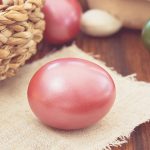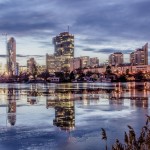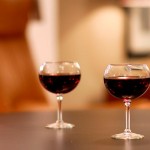Many of us may chomp on chocolate eggs at Easter, but originally eating eggs was not allowed by the church during the week leading up to Easter (known as Holy Week). So any eggs laid that week were saved and decorated to make them ‘Holy Week eggs’, then given to children as gifts.
The egg has long been a symbol of ‘fertility’, ‘rebirth’ and ‘the beginning’. In Egyptian mythology, the phoenix burns its nest to be reborn later from the egg that is left; Hindu scriptures relate that the world developed from an egg.
 With the rise of Christianity in Western Europe, the church adapted many pagan customs and the egg, as a symbol of new life, came to represent the Resurrection. Some Christians regarded the egg as a symbol for the stone being rolled from the sepulchre.
With the rise of Christianity in Western Europe, the church adapted many pagan customs and the egg, as a symbol of new life, came to represent the Resurrection. Some Christians regarded the egg as a symbol for the stone being rolled from the sepulchre.
A pregnant Roman woman carried an egg on their person to foretell the sex of their unborn children, while French brides stepped upon an egg before crossing the threshold of their new homes. Old Polish legends firmly attached the egg to the Easter celebrations and one folklore tells of the Virgin Mary giving eggs to the soldiers guarding the cross which held Jesus.
Eggs as an Easter gift
The earliest Easter eggs were hen or duck eggs decorated at home in bright colours with vegetable dye and charcoal. Orthodox Christians and many cultures continue to dye Easter eggs, often decorating them with flowers.
The 17th and 18th centuries saw the manufacture of egg-shaped toys, which were given to children at Easter. The Victorians had cardboard, ‘plush’ and satin covered eggs filled with Easter gifts and chocolates. The ultimate egg-shaped Easter gifts must have been the fabulous jewelled creations of Carl Fabergé made during the 19th century for the Russian Czar and Czarina, now precious museum pieces.
During the middle ages it became custom to decorate your egg (mainly Duck or Goose) with dye, paint or other decorations and competitions were held to find the best Easter Egg. Various games would also take place to lighten things for the children after the sombre mood of Lent. Parents would hide eggs for the children to find and so started the first Easter Egg Hunts which still take place today. Egg Rolling was also popular as a way of using up the eggs that had stock piled during Lent. A large hill was needed to add to the fun and the most famous egg roll still taking place today is the one on the White House lawn.
Around the world
In Greece, the eggs were painted bright red to symbolize the blood of Jesus, with pictures of Christ, the Virgin Mary and other holy figures being painted on. Germans gave green eggs as a Holy Thursday and hung hollow eggs on trees. Hollow eggs were created by piercing the shell with a needle and blowing the contents. Austrians placed tiny plants around the eggs and then boiled them. When the plants were removed, white patterns were created. In Poland, eggs were painted gold or silver while in the Ukraine eggs were waxed and patterns created with the wax being reapplied to seal the design.
Famous eggs
The household accounts of Edward I, for the year 1290, recorded an expenditure of eighteen pence for four hundred and fifty eggs to be gold leafed and coloured for Easter gifts. The most famous decorated Easter Eggs were made by the well-known goldsmith, Peter Carl Fabergé. In 1883, the Russian Czar, Alexander, commissioned Fabergé to make a special Easter gift for his wife, the Empress Marie. This egg was actually not a real egg, as the outside shell was made of platinum and enamelled white, which opened to reveal a smaller gold egg.
This in turn, opened to display a golden chicken and a jewelled replica of the Imperial crown. The Czarina was so delighted with this egg that further eggs were commissioned every Easter. In later years Nicholas II, Alexander’s son, continued the custom and fifty-seven eggs were made in all by Fabergé.
Chocolate
In the 17th Century, artificial eggs were made, using various materials, as these made excellent presents or gifts. These became popular and the first manufactured eggs started to appear, so it was only a matter of time before chocolate was used to create an Easter Egg. The first chocolate Eggs were solid and a paste was used made from ground roasted Cacao Bean. Germany and France produced these, but was quickly followed by the rest of Europe with the eggs being hollowed out.
By the turn of the 19th century the discovery of the modern chocolate making process and improved mass manufacturing methods meant that the hollow moulded egg was the most popular gift for Easter, but it wasn’t until the 1960’s that this was established worldwide.
Easter Bunny
The Rabbit or Hare was often used in Spring celebrations as a sign of fertility due to their frequent births. It was used in Germany first, with German immigrants taking the tradition to America, particularly Pennsylvania, were it spread to a much wider public. Sometimes the Easter Bunny was used to hide the Eggs for the Easter Hunt and cakes and biscuits were baked in bunny shapes. Of course today you are more likely to find a chocolate shaped Bunny or Hare.
Modern Easter Eggs
John Cadbury made his first ‘French eating Chocolate’ in 1842 but it was not until 1875 that the first Cadbury Easter Eggs were made. Progress in the chocolate Easter egg market was slow until a method was found for making the chocolate flow into the moulds.
The earliest chocolate eggs were made of ‘dark’ chocolate with a plain smooth surface and were filled with sugared almonds. The earliest ‘decorated eggs’ were plain shells enhanced by chocolate piping and marzipan flowers.
Now they come with film and celebrity endorsements. The most expensive chocolate egg was sold at auction in 2012 for £7,000.





